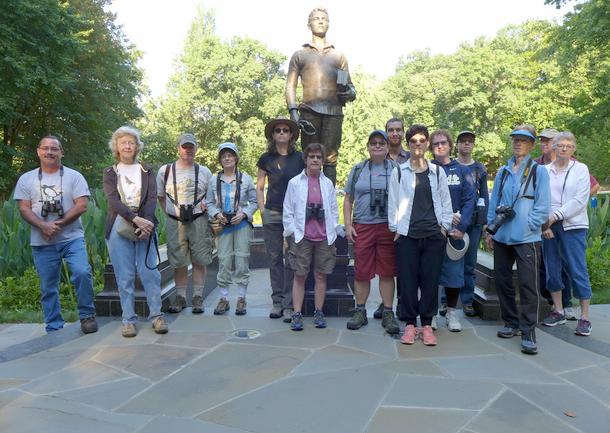
This morning 15 of us met at the Westinghouse Memorial pond for a walk along the Falloon Trail and Serpentine Road in Schenley Park.
For the most part birds were hard to find. Though we knew they were in the woods, they weren’t singing and the leaves were dense and dark. Ultimately we recorded 19 species. Complete checklist is here.
Best Birds:
- A male indigo bunting sang at golf course Hole #14 in the meadow next to the fairway.
- In the same location we found a Mystery Sparrow: mostly clear chest just a little stripey, very orange legs and a pink-orange bill. Tom Moeller took a photo and zoomed it in. Field sparrow.
- Our last bird was a small flycatcher hunting for bugs and not singing at all. I wondered if it was an Empidonax. No. Eastern wood-pewee. We heard other pewees and saw one begging from a singing adult.
- There were more American robins (22+) than species (19). Oy!
Best mammal: Fox squirrel in a tree.
Best flower: Joe-pye weed, a perennial in the sunflower family.
Best tree: Northern catalpa or the Toby Tree (the Pittsburgh name for it). Though I grew up in Pittsburgh I had never heard the name. Kimberly Thomas Googled it and found Chuck Tague’s blog Tobies: The Cigar Tree.
Best butterfly: Three Monarchs and the very common Eastern Tailed Blue which Tom Moeller identified for us.
Question: Is the black oak in the red oak group or the white oak group.
Answer: The black oak is a red oak.
(photo by Kate St. John)
p.s. The bronze statue in the photo represents a young man looking up to George Westinghouse.
Sorry I missed the outing today. They are always packed with good (and fun) information.
Not on point, but nice mention of you in today’s P-G about capturing tundra peregrines for falconry. My question is: Shouldn’t a master or general falconer be knowledgeable enough to spot the differences you describe? And, what happens to the bird if they capture the Pa-endangered American peregrine?
Anne Curtis